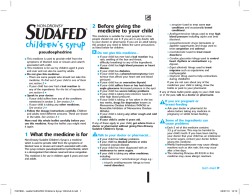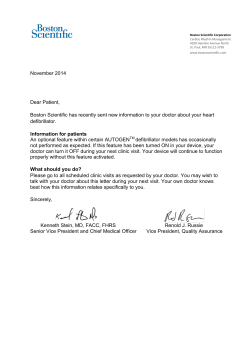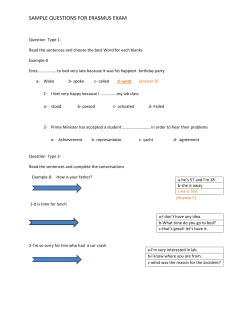
BIJSLUITER: INFORMATIE VOOR DE GEBRUIK(ST)ER - CBG-MEB
Business use only
Sandoz
1.3.1 spc-label-pl - common-pl - 5,519
(NL/H/0795-809-810/001-002)
FLECAINIDE ACETATE 100 MG; 50 MG TABLET
Page 1 of 6
20150113
800-1126.00 800-1127.00
Package leaflet: Information for the user
[Nationally completed name] 50 and 100 mg tablets
Flecainide acetate
Read all of this leaflet carefully before you start taking this medicine because it contains
important information for you.
Keep this leaflet. You may need to read it again.
If you have any further questions, ask your doctor or pharmacist.
This medicine has been prescribed for you only. Do not pass it on to others. It may harm them,
even if their signs of illness are the same as yours.
If you get any side effects talk to your doctor, pharmacist or nurse. This includes any possible
side effects not listed in this leaflet. See section 4.
What is in this leaflet:
1.
What [Nationally completed name] is and what it is used for
2.
What you need to know before you take [Nationally completed name]
3.
How to take [Nationally completed name]
4.
Possible side effects
5.
How to store [Nationally completed name] – 50 and 100 mg tablets
6.
Contents of the pack and other information
1.
What [Nationally completed name] is and what it is used for
[Nationally completed name] belongs to the group of medicines that work against cardiac arrhythmia
(known as anti-arrhythmics). It inhibits stimulus conduction in the heart and extends the time during
which the heart is at rest, causing the heart to pump normally again.
[Nationally completed name] is used
- for certain serious cardiac arrhythmias, which are often expressed as serious palpitations of the
heart or tachycardia.
- for serious cardiac arrhythmias that did not respond well to treatment with other medicines, or
when other treatments cannot be tolerated.
2.
What you need to know before you take [Nationally completed name]
Do not use [Nationally completed name]
- if you are allergic to flecainide or any of the other ingredients of this medicine (listed in section 6)
- if you suffer from another heart condition, different from the heart condition for which you are
taking this medicine. If you are unsure, or if you would like additional information, consult your
doctor or pharmacist,
- if you are taking certain other antiarrhythmics (sodium channel blockers, such as disopyramide and
quinidine) as well.
Warnings and precautions
Talk to your doctor before taking [Nationally completed name]
- if you suffer from a reduced liver function and/or reduced kidney function, since the concentration
of flecainide in the blood may increase. In that event, your doctor may regularly have the
concentration of flecainide in the blood checked,
Business use only
Sandoz
1.3.1 spc-label-pl - common-pl - 5,519
(NL/H/0795-809-810/001-002)
FLECAINIDE ACETATE 100 MG; 50 MG TABLET
Page 2 of 6
20150113
800-1126.00 800-1127.00
-
if you have a permanent pacemaker or temporary pacing electrodes,
if you have suffered from cardiac arrhythmias after heart surgery,
if you suffer from severe bradycardia or pronounced hypotension.
if you have experienced a heart attack. These conditions should be corrected before using
[Nationally completed name].
A lowered or elevated level of potassium in the blood may influence the effect of [Nationally
completed name]. Potassium levels should be corrected before using [Nationally completed name].
Children below 12 years
Flecainide is not approved for use in children below the age of 12 years, however
flecainide toxicity has been reported during treatment with flecainide in children who reduced their
intake of milk, and in infants who were switched from milk formula to dextrose feedings.
Other medicines and [Nationally completed name]
If you use certain other medicines along with [Nationally completed name], the medicines can
sometimes affect the way each other work and/or their side effects (i.e. there may be interactions).
Interactions may occur when using this medicine with for example:
- sodium channel blockers (class I anti arrhythmics), such as disopyramide and quinidine: see
section “Do not use [Nationally completed name]",
- beta blockers such as propranolol (medicines that reduce the heart’s pumping function,
- amiodarone (for heart conditions); the dose of [Nationally completed name] must be reduced for
some patients,
- calcium channel blockers, such as verapamil (lower the blood pressure),
- diuretics, laxatives (medicines that stimulate bowel movement) and adrenal cortex hormones
(corticosteroids): your doctor may have the amount of potassium in your blood checked.
- mizolastine and terfenadine (medicines to treat allergies named “antihistamines” ),
- ritonavir, lopinavar and indinavir (medicines to treat HIV-infections),
- fluoxetine, paroxetine and certain other antidepressants named “tricyclic antidepressants”,
- phenytoin, phenobarbital and carbamazepine (medicines against epilepsy): the breakdown of
flecainide may be accelerated by these substances,
- clozapine, haloperidol and risperidon (medicines to treat psychotic disorders named
“neuroleptics”),
- quinine (medicine against malaria),
- terbinafine (medicine to treat fungal infections named “antimicotic”),
- cimetidine (an antacid); this may increase the effect of [Nationally completed name],
- bupropion (anti-smoking medicine),
- digoxin (a medicine to stimulate the heart); [Nationally completed name] may raise the level of
digoxin in your blood.
Tell your doctor or your pharmacist if you are using, have recently used, or might use any other
medicines. This also applies to other medicines that are available without prescription, herbal
medication, or natural products.
[Nationally completed name] with dairy products
Dairy products (milk, infant formula and possibly yoghurt) may reduce the absorption of flecainide in
children and infants. Flecainide is not approved for use in children below the age of 12 years,
however flecainide toxicity has been reported during treatment with flecainide in children who
Business use only
Sandoz
1.3.1 spc-label-pl - common-pl - 5,519
(NL/H/0795-809-810/001-002)
FLECAINIDE ACETATE 100 MG; 50 MG TABLET
Page 3 of 6
20150113
800-1126.00 800-1127.00
reduced their intake of milk, and in infants who were switched from milk formula to dextrose
feedings.
Pregnancy and breast-feeding
Flecainide crosses the placenta and passes into breast milk in small amounts. If you are pregnant or
breast-feeding, think you may be pregnant, or are planning to have a baby, ask your doctor for advice
before taking this medicine.
Do not take this medicine during pregnancy and breast-feeding unless your doctor has specifically
recommended it.
Driving and using machines
If you suffer from side effects such as dizziness, double vision or blurred vision, or if you feel light in
the head, then your ability to react may be reduced. This may be dangerous in situations that demand
concentration and attentiveness, such as using the road, handling dangerous machinery or working at
heights. If you are unsure whether this medicine is having a negative effect on your ability to drive,
discuss this with your doctor.
3.
How to take [Nationally completed name]
Always take this medicine exactly as your doctor or pharmacist has told you. Check with your doctor
or pharmacist if you are unsure. Your doctor will prescribe a personalised dose, adjusted to fit your
complaints. Treatment with [Nationally completed name] will normally be started under medical
supervision (if necessary, in the hospital).
When and how should the tablets be taken?
Take the tablets by swallowing them with sufficient fluid (e.g. water). The daily dose is usually taken
split up over the day, on an empty stomach, or at least one hour before meals.
The general dose is just a guideline and is as follows:
the usual starting dose lies between 50 and 200 mg. The dose may be increased by your doctor to a
maximum of 400 mg a day.
More elderly patients
Your doctor may prescribe a lower dose for you. The dose for elderly patients should not exceed
300 mg daily (or 150 mg twice daily).
Patients with a reduced kidney or liver function
Your doctor may prescribe a lower dose for you.
Patients with a permanent pacemaker
The daily dose must not exceed 100 mg twice a day.
Patients who are simultaneously being treated with cimetidine (medicine against gastric disorders) or
amiodarone (medicine against cardiac arrhythmia)
The doctor will check you regularly, and a lower dose will be prescribed for some patients.
During treatment, your doctor will regularly determine the level of flecainide in the blood and what is
known as an electrocardiogram (ECG) of the heart will be taken. A simple ECG must be taken once a
month and a more extensive ECG once every three months. An ECG will be taken every 2 to 4 days at
the start of the treatment and when the dose is raised.
An ECG must be taken more frequently for patients who are receiving a smaller dose than is usually
prescribed. The doctor can adjust the doses at intervals of 6 to 8 days. An ECG will be taken for these
patients at weeks 2 and 3 after the start of the treatment.
Business use only
Sandoz
1.3.1 spc-label-pl - common-pl - 5,519
(NL/H/0795-809-810/001-002)
FLECAINIDE ACETATE 100 MG; 50 MG TABLET
Page 4 of 6
20150113
800-1126.00 800-1127.00
Use in children
These tablets should not be taken by children under the age of 12 years.
If you take more [Nationally completed name] than you should
If you suspect an overdose, you must alert a doctor immediately.
If you forget to take [Nationally completed name]
Take the dose when you discover that you have forgotten to take it, unless you only discover this
when it is almost time to take your next dose. In the latter case, you must not take the dose that you
forgot as an addition but should continue to follow your schedule. It is important to take the tablets
according to the schedule. Consult your doctor if you have any doubts.
Do not take a double dose to make up for a forgotten tablet.
If you stop taking [Nationally completed name]
If you suddenly stop taking [Nationally completed name] you will not get withdrawal symptoms.
However, the cardiac arrhythmia will no longer be being controlled as intended. So never stop using it
without your doctor knowing.
If you have any further questions on the use of this medicine, ask your doctor, pharmacist or nurse.
4.
Possible side effects
Like all medicines, this medicine can cause side effects, although not everybody gets them.
The side effects that may occur include the following:
very common (in more than 1 in 10 patients):
dizziness, problems with vision, such as double vision and blurred vision
common (in more than 1 in 100 patients):
appearance of a more severe type of arrhythmia or an increase in frequency or severity of an existing
arrhythmia, shortness of breath, weakness, tiredness (fatigue), fever and accumulation of fluid in the
tissue (oedema)
uncommon (in more than 1 in 1000 patients):
decrease in red and white blood cells and platelets, increased heart rate in patients with atrial flutter,
nausea, vomiting, constipation, abdominal pain, decreased appetite, diarrhoea, indigestion, wind,
allergic skin reactions such as rash, hair loss
rare (in more than 1 in 10,000 patients):
seeing, hearing or feeling things that are not there (hallucinations), depression, confusion, anxiety,
amnesia, sleeplessness, tingling of the skin (“as if ants are walking over it”), coordination problems,
decrease of sensitivity, increased sweating, fainting, tremor, flushing, sleepiness, headache, nervous
disorders e.g. in the arms and legs, convulsions, difficulties in movement (tics), ringing in the ears,
spinning sensation (vertigo), inflammation of the lung, elevated liver enzymes with or without yellow
eyes or skin, and serious hives
very rare (in fewer than 1 in 10,000 patients):
Business use only
Sandoz
1.3.1 spc-label-pl - common-pl - 5,519
(NL/H/0795-809-810/001-002)
FLECAINIDE ACETATE 100 MG; 50 MG TABLET
Page 5 of 6
20150113
800-1126.00 800-1127.00
elevated levels of certain antibodies which may indicate an autoimmune disease (with or without
inflammation in the body), deposits in the cornea of the eye, increased sensitivity of the skin to
sunlight
Frequency not known (cannot be estimated from the available data):
certain changes in the electrocardiogram (increase in PR and QRS intervals), increase in pacing
threshold in patients with pacemakers or temporary pacing electrodes, impairment of the conduction
between the atria and ventricles of the heart (second or third degree atrioventricular block), stopped
heart beat, slower or faster heart beat, loss of the heart’s ability to pump enough blood to the body's
tissues, chest pain, low blood pressure, heart attack, feeling your heart beat, a pause in the normal
cardiac rhythm (sinus arrest), life-threatening irregular heartbeat (ventricular fibrillation), appearance
of a certain pre-existing heart disease (Brugada syndrome) which was not seen before the treatment
with [Nationally completed name], scarring of the lungs or lung disease (named interstitial lung
disease which causes breathlessness), liver disorder
If you get any side effects talk to your doctor, pharmacist or nurse. This includes any side effects not
listed in this leaflet.
Reporting of side effects
If you get any side effects, talk to your doctor or, pharmacist or nurse. This includes any possible side
effects not listed in this leaflet. You can also report side effects directly via the national reporting
system listed in Appendix V*. By reporting side effects you can help provide more information on the
safety of this medicine.
5.
How to store [Nationally completed name]
Keep this medicine out of the sight and reach of children.
This medicine does not require any special storage conditions.
Do not use this medicine after the expiry date which is stated on the package after “Do not use after”
or “Exp”. The expiry date refers to the last day of that month. Do not throw away any medicines via
wastewater. Ask your pharmacist how to throw away medicines you no longer use. These measures
will help protect the environment.
6.
Contents of the pack and other information
What [Nationally completed name] contains
The active substance is: flecainide acetate
One tablet contains 50 mg flecainide acetate
One tablet contains 100 mg of flecainide acetate
The other ingredients are: croscarmellose sodium (E468), magnesium stearate (E470b),
pre-gelatinised corn starch, corn starch and microcrystalline cellulose (E460)
What [Nationally completed name]– 50 and 100 mg tablets look like and contents of the pack
The 50 mg tablet is round and white, with the inscription “C” on one side and “FI” on the other. The
100 mg tablet is round and white with a break line on one side, with the inscription “FJ” on one side
of the line and “C” on the other side, and a break line on the other side.
<All pack sizes for this pharmaceutical form and strength>
BLISTER: ALU/PVC/PVDC
Business use only
Sandoz
1.3.1 spc-label-pl - common-pl - 5,519
(NL/H/0795-809-810/001-002)
FLECAINIDE ACETATE 100 MG; 50 MG TABLET
Page 6 of 6
20150113
800-1126.00 800-1127.00
Pack sizes: 20, 28, 30, 50, 56, 60, 84, 90, 100, 112, 120, 168, 180
BOTTLE: Containers of polypropylene with snap-on polyethylene lids.
Pack sizes: 100, 250, 500, 1000
Not all pack sizes may be marketed.
Marketing Authorisation Holder and Manufacturer
[To be completed nationally]
For any information about this medicine, please contact the local representative of the Marketing
Autorisation Holder:
<name and addres MAH>
This medicinal product is authorised in the Member States of the EEA under the following
names:
{Name of the Member State}
{Name of the Member State}
{Name of the medicinal product}
{Name of the medicinal product}
This leaflet was last revised in (MM/YYYY)
[To be completed nationally]
© Copyright 2025









